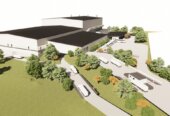If you want an example of how sensational headlines can be about geology, the East African Rift is a prime example. A few years ago, photos of a large crack made the rounds, making it seem like the ground was pulling apart right then and there, with headlines like, “Large crack in East African Rift is evidence of continent splitting in two.”

Janine Krippner
Geologists were quick to jump in and point out that this “crack” was actually a gully formed by erosion, where dirt was being washed away by water. So, it was never a crack at all. But why let facts get in the way of a good story, right?
Science is for all of us, and that includes geology. This is our beautiful planet, and understanding how it works feeds into how we can live in harmony with it.
We don’t need a “crack” for evidence. We’ve known about the African rift system for a long time. It began about 25 million years ago, so at this point, it’s not shocking. It is, however, a very cool example of active plate tectonics.
The rift zone is a divergent boundary, where tectonic plates pull apart due to the underlying processes of our active Earth. This isn’t rare on our planet, but we don’t usually see it on a continent. We do see the Mid-Atlantic Rift popping up above the ocean to form Iceland, but the rest of these enormous systems are hidden beneath the sea.
The Mid-Atlantic Ridge is an incredible region with a lot still to discover because of its inaccessibility deep below the ocean, and we can learn even more by exploring examples on land. These systems stretch thousands of kilometres and are composed of faults, volcanic and hydrothermal activity, thinning crust, and new land formation. They happen very slowly, especially on human time scales, but they steadily shape our planet. There’s such beauty in these powerful yet slow processes that have led to our continents and oceans being where they are today.
If you look at a map, one of the clearest examples is how the eastern side of South America and the western side of Africa look like they were once joined. Because they were. In the biggest, most epic show of slow and steady, they have made about 7,000 km of progress. How’s that for an inspiration poster child?
These scales are tough to comprehend. Millions of years and vast distances make it look like nothing is moving at all. But when it does move quickly near us, we notice it—like when there’s a release of pressure during a large earthquake. Tectonics is a slow process, until it isn’t.
So yes, there will one day be a new ocean splitting Africa, but it’s not happening at shocking speed. And us geologists are not “scrambling” because of it. We are, however, driven by a love of understanding our planet at all scales and speeds, and like many of you, we are always fascinated to learn more.









